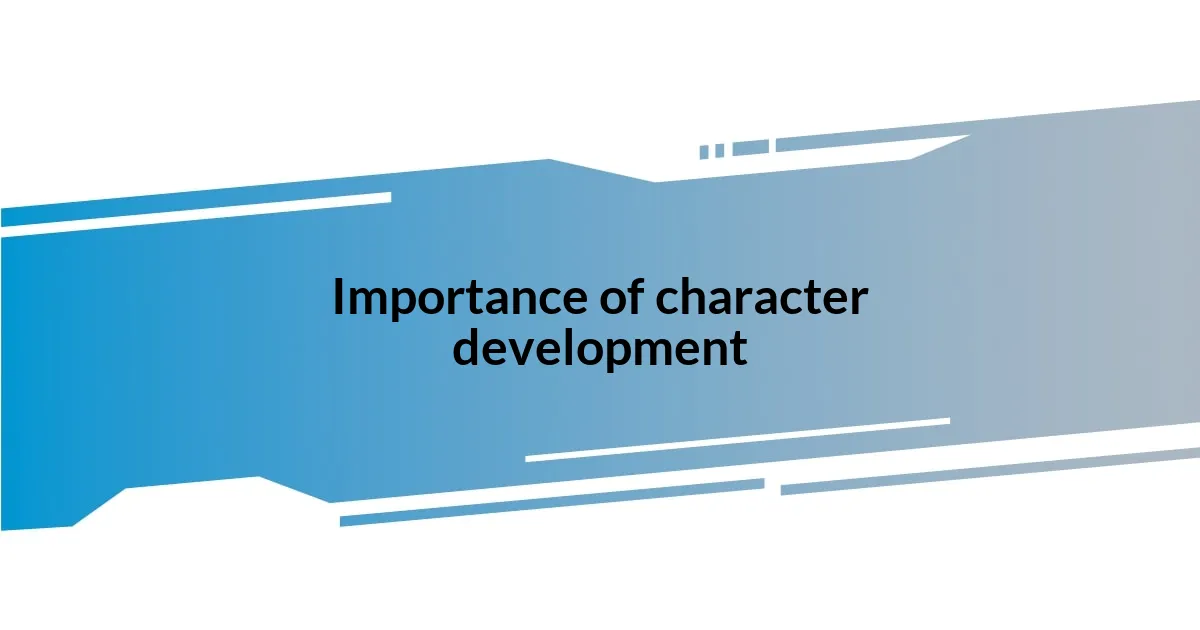Key takeaways:
- Character arcs are crucial for character development and relatability, reflecting internal struggles and growth throughout the story.
- Different types of character arcs, such as transformation, redemption, and tragic arcs, create diverse experiences for readers and enhance storytelling.
- Common pitfalls include abrupt changes without buildup, static characters despite challenges, and predictable arcs; maintaining authenticity and emotional depth is essential for engagement.

Understanding character arcs
Character arcs are the paths characters take as they evolve over the course of a story, often reflecting their internal struggles and resolutions. I remember working on a story where my protagonist began as a self-centered individual, but I had to allow her vulnerabilities to shine through. Watching her grow into someone more empathetic felt rewarding—it made me realize how pivotal a character arc is to creating relatable narratives.
Have you ever noticed how some characters resonate deeply while others fade into the background? This often stems from well-crafted character arcs. When I read a book where characters experience significant changes—like learning to trust others or overcoming fears—I find myself emotionally invested in their journeys. It’s fascinating how an arc can elevate a character from mere caricature to a complex person who mirrors our own struggles.
Diving deeper, it’s crucial to understand that character arcs don’t always follow a linear progression. In my experience, a character might regress before they progress, which adds authenticity. For instance, I wrote a character who, after achieving a breakthrough, suddenly faced a setback. This not only enhanced the story’s tension but also made the eventual resolution more impactful. How can one not appreciate the nuance of a character wrestling with their growth? It truly mirrors the complexities of human nature.

Types of character arcs
When it comes to character arcs, I’ve observed a few distinct types that help define a character’s journey. I’ve experienced this firsthand in my writing, where I often lean toward transformation arcs, which depict a character evolving significantly, like when my antagonist turned into an ally by the end of the tale. Such dramatic shifts can be really engaging!
Here are some common types of character arcs:
- Transformation Arc: Characters undergo significant change, like moving from selfishness to selflessness.
- Flat Arc: The character remains largely the same but influences others’ perspectives or beliefs, as I’ve seen in wise mentors.
- Redemption Arc: A character seeking forgiveness or a second chance, often compelling, due to the emotional stakes involved.
- Tragic Arc: This emphasizes decline, often showing how a character’s choices lead to their downfall—something I tried with a heartbreaking character in one of my stories.
- Growth Arc: A gradual evolution where a character learns and adapts but remains fundamentally the same, which I find relatable in many everyday situations.
Each arc type resonates differently with readers, and understanding these nuances has transformed how I approach character development in my stories. Drawing from these various arcs allows me to create more dynamic relationships that capture the intricacies of real life.

Importance of character development
Character development is critical because it infuses depth into a story, making it resonate with readers on a personal level. I’ve come across instances where characters evolve in surprising ways, leading to unexpected reader connections. For example, in one of my narratives, a minor character turned out to be the secret hero, illustrating how even seemingly small arcs can enhance the overall story and evoke emotional responses.
When I reflect on the stories that stayed with me, it’s often the character development that captivates me most. I remember reading a novel where the protagonist struggled with self-acceptance. Watching her journey through triumphs and setbacks truly impacted my understanding of personal growth. This connection between reader and character underscores the importance of crafting well-rounded arcs.
Developing characters thoughtfully can create a mirror for our own experiences. I’ve noticed that when authors take the time to flesh out a character’s journey, it allows readers to examine their complexities. One time, I crafted a character who grappled with overcoming anxiety. Her small victories felt like my own, reinforcing the notion that character arcs serve as a conduit for empathy and reflection.
| Aspect | Impact |
|---|---|
| Depth | Engages readers emotionally |
| Relatability | Mirrors real-life struggles |
| Connection | Creates lasting impressions |

Key components of character arcs
Understanding the key components of character arcs can significantly enhance the ways I create complex narratives. For instance, a well-defined goal or desire motivates the character’s decisions and drives the plot forward. I once had a character who desperately wanted to prove her worth after a major failure. Watching her chase this ambition not only made her relatable but allowed me to explore themes of perseverance and resilience.
Another vital element is the internal conflict that tests the character’s beliefs and values. When I crafted a character torn between loyalty to friends and a newfound sense of justice, it brought emotional depth to the story. I found myself drawn into her struggles, wondering what choices I might make in similar circumstances. This internal battle can evoke strong connections with readers, as they often see pieces of themselves in these dilemmas.
Finally, the resolution of a character’s journey plays a crucial role in completing their arc. It’s not just about what happens but how the character has changed by the end. I remember writing a conclusion where my protagonist no longer sought external validation, realizing her worth came from within. This final moment of clarity resonated deeply with me, reaffirming my belief that character arcs are not just about change, but about the meaningful realization that often accompanies it. How can we not connect with someone who learns to embrace their true self?

Common pitfalls in character arcs
When it comes to character arcs, one common pitfall is creating a character who undergoes change too abruptly. I’ve been guilty of this myself; I once crafted a character who flipped her beliefs from one extreme to another without sufficient buildup. Readers were left puzzled instead of engaged, feeling like they missed the emotional journey that should have connected them to her transformation. How can you truly resonate with a character if their evolution feels unearned?
Another frequent mistake is having a character’s arc remain static despite external pressures. I can recall a story where the protagonist faced relentless challenges yet remained unchanged. This dissonance left readers frustrated. It’s essential to ensure that external conflicts impact the character internally, prompting growth or revealing deeper flaws. After all, why would we invest in a journey where the character doesn’t respond to their circumstances?
Finally, an overly predictable arc can deflate excitement and engagement. I did this when I anticipated my character’s journey would go one way, only to realize it ultimately followed clichéd trails. Readers can sense when an arc feels safe or formulaic, and they often disengage as a result. Striving for authenticity and surprise in the character’s development often leads to richer encounters and authentic storytelling. Isn’t it much more satisfying when characters break free from expectations?

Analyzing successful character arcs
Navigating the intricacies of successful character arcs has always fascinated me. One arc that truly stands out was a character who transitioned from a self-absorbed entrepreneur to a community-oriented leader. As I wrote her transformation, I felt a surge of excitement, questioning how empathy could reshape one’s identity. This made me realize that authentic character growth hinges on deep, relatable motivations.
Moreover, I’ve found that consistency is crucial in character development. There was a time when I introduced a subplot involving a character’s childhood trauma, only to have her act inconsistently in key scenes. This oversight left readers feeling confused and disconnected. I often ask myself how a character can truly evolve if their internal logic falters. A character’s journey must feel cohesive and believable, allowing the audience to invest emotionally.
Lastly, I’ve observed that successful arcs often come from exploring complex relationships. I once created a character whose growth depended heavily on the friendship she forged with a rival. Their dynamic challenged her worldview and sparked numerous moments of introspection. It’s these multifaceted interactions that not only push characters to change but also invite readers to reflect on their own relationships. How often do we learn more about ourselves through our connections with others? By emphasizing this, we craft narratives that resonate on multiple levels.
